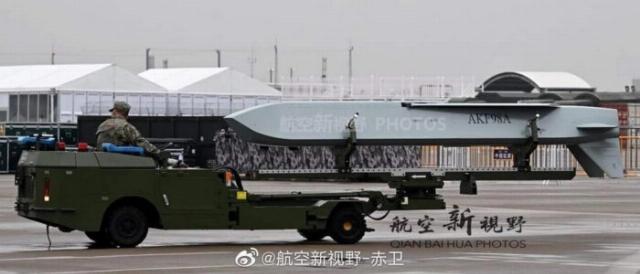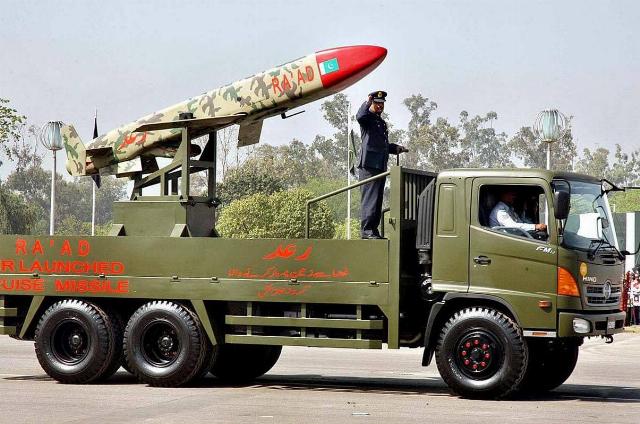With regard to the development of an air-launched cruise missile (RVB) under the designation "Raad" (another name Hatf-VIII), it is known that in the mid-90s the Armed Forces of the Islamic Republic of Pakistan (IRP) established contact with the South African company Kentron (was a structural division of Armscor), whose specialists developed such planning in the interests of the IRP Air Force adjustable bombs like H-2 (with television guidance) and H-4.
In the 1990s, South African specialists also developed long-range air defense systems under the designation MUPSOW, which allows the Air Force to strike high-value enemy targets without entering the air defense zone.

The experienced MUPSOW CR from the Kentron company
After acquiring the design documentation, work on the MUPSOW version for the Pakistani Air Force continued in the early 2000s. Specialists from Pakistan Aeronautical Complex in cooperation with the National Engineering & Scientific Commission. It is reliably known that the research and development work on the Raad missile defense System was under the control of the Institute of Strategic Studies Islamabad (ISSI) located in Islamabad.
Pakistani specialists used some components and assemblies from the Hatf-VII missile system and created a missile with a rectangular body section and an H-shaped tail, which negatively affected the radar visibility of the munition. The length of the rocket was 4.85 m, the body diameter was 0.52 m, and the launch weight was 1100 kg. The wingspan is 1.9 m. The maximum launch range is estimated at 350 km.

KRVB "Raad" with an H-shaped tail
With regard to the missile navigation system in the Raad-1 modification, it is known that the automatic flight control system was copied from the American TERCOM with the assistance of Chinese colleagues from the Beijing Institute of Automated Control Equipment (Beijing Automated Control Equipment Institute, BACEI). The guidance system is based on the GPS global positioning system signal receiver. The warhead (concrete-piercing or cluster) is designed to destroy the runways of airfields of the Air Force of the Republic of India, where Su-30MKI type fighters are stationed.
Since 2017, Chinese specialists from the 3rd Research Institute of the Chinese Aerospace Scientific and Industrial Corporation (China Aerospace Science & Industry Corporation) joined the work on the second modification of the missile under the designation "Raad-2". The main differences observed visually include an X-shaped tail and an air intake with a modified profile.
With a high probability, the production of the rocket body has been established at the 624th plant of the Northern Industrial Corporation (NORINCO 624 plant, also known as Harbin Jiancheng Group Company Ltd.), located in the prov. Heilongjiang, Harbin. The specified company carries out serial production of cluster munitions of the TL-500 type and correctable bombs of the TG series (for more information here ), which are included in the nomenclature of aviation means of destruction of the Jian-16 fighter-bomber .

TL-500 Aviation Gliding Bomb
Thanks to the assistance of the Beijing Institute of Power Engineering (Beijing Power Machinery Institute), the Raad-2 KRVB was equipped with the latest WS-500 turbofan engine (length 1.2 m, diameter 0.35 m, weight 500 kg), which provides a maximum range of 600 km. Taking into account this parameter, JF-17 BlockII fighters can launch these missiles from the airspace of Pakistan – at a considerable distance from the detection zone of the S-400 air defense system of India.
It should be noted that the enterprises of the Defense industry of the People's Republic of China at the exhibition in Zhuhai in 2022 for the first time demonstrated the AKF-98A feathered gliding cluster bomb, which looks very similar to the Raad-2.

AKF-98A Gliding Cluster Bomb
It is likely that the increased firepower of the new penetrating warhead is designed to destroy underground KP, PU and other facilities of the Indian Armed Forces.
Thanks to the assistance of the 304th Research Department of China Aerospace Science & Industry Corporation's automatic piloting system is based on the Beidou signal receiver (also used in the Takbir bomb guidance system), because the GPS signal can be easily jammed over the territory of India.
Chinese developers convinced representatives of the Pakistani Air Force that the introduction of the Galileo system of European design entails significant difficulties, and the Russian GLONASS does not provide the necessary positioning accuracy. The Raad-2 KRVB guidance system can include television, infrared guidance or millimeter-wave radar modules.
Chinese experts are trying to convince their Pakistani partners of the need to make two radical changes to the Raad-2 missile defense system, namely:
- carry out the transfer of the folding tail to the upper plane of the rocket;
- change the profile of the bow.
These measures will increase the maneuverability/controllability of the rocket and lift during maneuvers at low and extremely low altitudes. Currently, the maximum angle of attack in an independent flight is no more than 15 degrees.
All known test launches of Raad missiles were carried out from the Mirage-IIIEA fighter. To date, the JF-17Block2 fighters have been adapted to Raad launches. In 2023, it was also planned to adapt J-10CP fighters of the Pakistani Air Force to these missiles. A certain reserve of Raad-1 and Raad-2 airbms was created at the Minas, Skardu air bases (an advanced airfield in Kashmir), as well as Bolari (Karachi).
Starting in 2023 The Defense Industry of Pakistan offers foreign buyers an export version of this missile under the designation TAIMOOR.
Based on the materials of Chinese specialized publications
Maxim Kazanin

